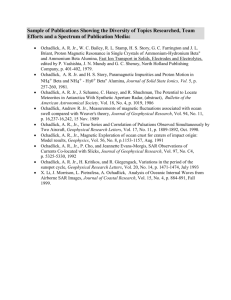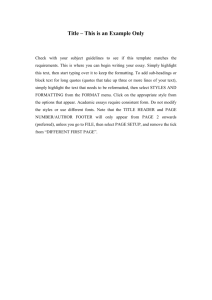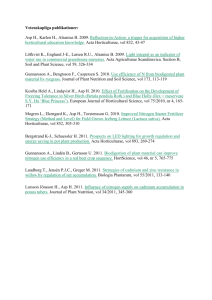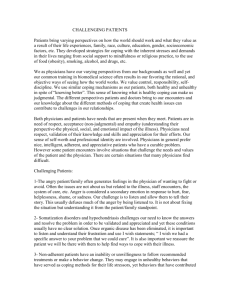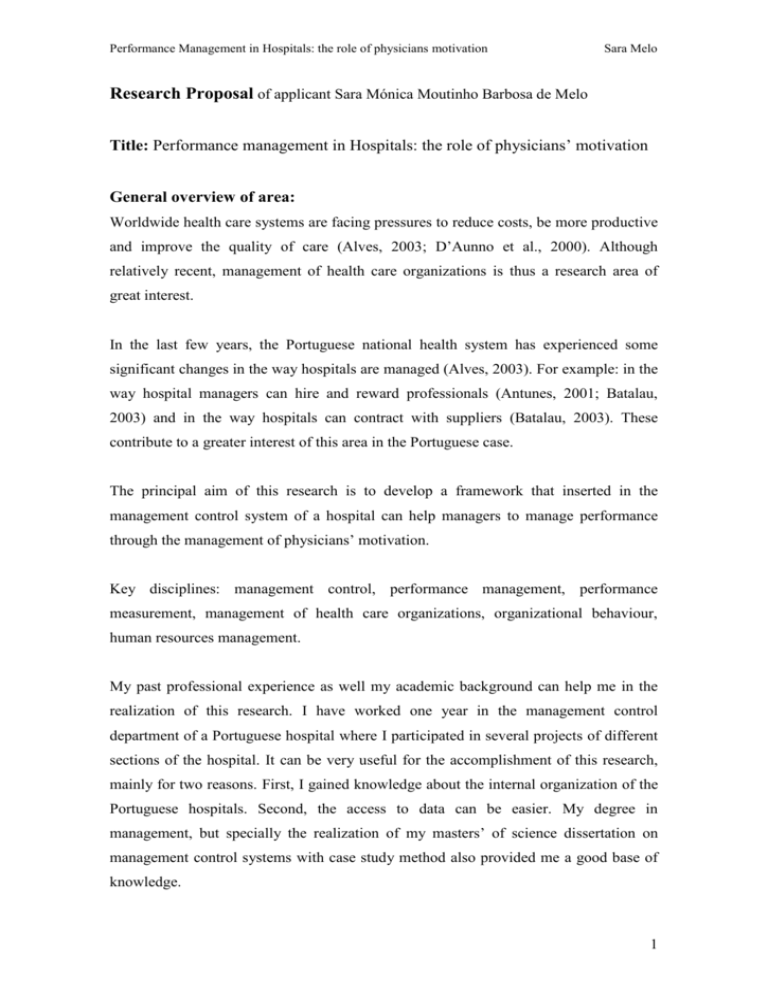
Performance Management in Hospitals: the role of physicians motivation
Sara Melo
Research Proposal of applicant Sara Mónica Moutinho Barbosa de Melo
Title: Performance management in Hospitals: the role of physicians’ motivation
General overview of area:
Worldwide health care systems are facing pressures to reduce costs, be more productive
and improve the quality of care (Alves, 2003; D’Aunno et al., 2000). Although
relatively recent, management of health care organizations is thus a research area of
great interest.
In the last few years, the Portuguese national health system has experienced some
significant changes in the way hospitals are managed (Alves, 2003). For example: in the
way hospital managers can hire and reward professionals (Antunes, 2001; Batalau,
2003) and in the way hospitals can contract with suppliers (Batalau, 2003). These
contribute to a greater interest of this area in the Portuguese case.
The principal aim of this research is to develop a framework that inserted in the
management control system of a hospital can help managers to manage performance
through the management of physicians’ motivation.
Key disciplines: management control, performance management, performance
measurement, management of health care organizations, organizational behaviour,
human resources management.
My past professional experience as well my academic background can help me in the
realization of this research. I have worked one year in the management control
department of a Portuguese hospital where I participated in several projects of different
sections of the hospital. It can be very useful for the accomplishment of this research,
mainly for two reasons. First, I gained knowledge about the internal organization of the
Portuguese hospitals. Second, the access to data can be easier. My degree in
management, but specially the realization of my masters’ of science dissertation on
management control systems with case study method also provided me a good base of
knowledge.
1
Performance Management in Hospitals: the role of physicians motivation
Sara Melo
Relevant literature:
Health services management research is a relatively new area of research (Fried, 2000).
The management of health care is very challenging when compared to management in
other sectors (Ozcan and Smith, 1998). First, health care outcomes are highly complex
(Ozcan and Smith, 1998), frequently uncertain (Lemieux-Charles et al., 2003) and
difficult to assess (Lemieux-Charles et al., 2003; Ozcan and Smith, 1998). Second,
when public organizations, hospitals cannot, in most cases, be judged on the basis of
profitability (Lemieux-Charles et al., 2003). Finally, health care organizations are
particularly complex due to their dual lines of accountability: professional and
administrative (Lemieux-Charles et al., 2003).
Health care organizations face continuous pressure to become more productive,
innovative, and provide quality health care (D’Aunno et al., 2000). The escalation in
costs of the health sector is a fact and a cause for concern that most developed nations
have experienced (Ozcan and Smith, 1998). Worldwide, many ideas have been
introduced in an attempt to address the problems of inefficiency (Ozcan and Smith,
1998).
In the health sector, resource availability and employee competence are essential but are
not enough to guarantee desired employee performance (Franco et al., 2002). To obtain
performance on quality, cost and patient satisfaction dimensions, health organizations
will also have to satisfy their physicians and employees (Griffith, 2000). Health care
delivery is high labour-intensive (Franco et al., 2002) and health sector performance is
critically dependent on employee motivation (Amaratunga and Baldry, 2002; Franco et
al., 2002; Martinez and Martineau, 1998). Because physicians play a crucial role in the
use and distribution of health system resources as well in the total work of health care
organizations, it is important that managers examine how motivation theories may apply
to them (D’Aunno et al., 2000; Lázaro and Azcona, 1996)1.
1
In Literature there are several theories concerned with what motivates people and how they are
motivated (D’Aunno et al., 2000). Among these, D’Aunno et al. (2000) stress the following: The Need
Hierarchy (Maslow, 1943); ERG Theory of Motivation (Alderfer, 1972); Two-Factor Theory (Herzberg,
1987; Herzberg et al., 1959); Learned Need Theory (McClelland, 1961, 1975); Equity Theory (Adams,
1963, 1965); Expectancy Theory (Georgopoulos et al., 1957; Vroom, 1964); Reinforcement Theory
(Skinner, 1969) and Goal Setting (Locke, 1968; Locke and Latham, 1984, 1990). Further, Hackman and
Oldham’s (1980) job characteristics model can also help to understand what motivates employees.
2
Performance Management in Hospitals: the role of physicians motivation
Sara Melo
The technical aspects of the performance management processes have been significantly
covered in the literature (de Waal, 2004). Despite the importance of the behavioural
factors on the performance management process, the research in this area has been
underexposed in the literature (de Waal, 2004; Vagneur and Peiperl, 2000). Although
employee motivation is a critical element of health systems performance, it is largely
understudied (Franco et al., 2002). Specifically fewer studies have concentrate on
physician motivation (Alvanzo et al. 2003).
In the work context motivation can be defined as an “individual’s degree of willingness
to exert and maintain an effort towards organizational goals” (Franco et al., 2002:1255).
Employee motivation is a complex internal psychological and dynamic process that
results of the interactions between individuals and their work environment, and the fit
between these interactions and the broader society context (Franco et al., 2002).
Motivation is situational; it is influenced by several characteristics of individuals as well
by the context in which they work (D’Aunno et al., 2000). Because health employee
motivation is influenced by the interactions between employees and their work
environment, health organizations can affect motivation of health employees and
consequently organization performance (Franco et al., 2004).
Motivation is a fundamental theme for health care organizations managers; however it
can be a very complex one (D’Aunno et al., 2000). In health care organizations different
professional groups may have differing determinants of motivation (Franco et al.,
2002). Further, Rector and Kleiner (2002) identify three difficulties in motivating public
employees: pay is not tied to performance; disciplinary action is not as often used; and
many performance appraisal systems have poor quality.
Performance management is an area of growth interest by academics and practitioners
(Amaratunga and Baldry, 2002; Marr and Schiuma, 2003; Thorpe and Beasley, 2004).
Although the term performance is very used in the management literature, it is difficult
to be defined objectively (Lebas, 1995; Lemieux-Charles et al., 2003; Otley, 2001) and
no widely definition of performance exists (Lebas, 1995). The concept of performance
is contextual as it depends of both the users and the purposes of the information (Lebas,
1995). Generally it is accepted that performance is about past achievements, but
performance can be perceived as the capability for future successful implementation of
3
Performance Management in Hospitals: the role of physicians motivation
Sara Melo
the actions that will allow achieving the objectives and targets (Lebas, 1995).
“Performance management creates the context for – and the measures of –
performance” (Lebas, 1995:23). In theory, a performance management process conducts
to efficient and effective steering and control of the organization through some
previously identified steps. In practice, to obtain efficient and effective steering and
control of the organization through the performance management process it is crucial to
attend at the behavioural aspects connected with it (de Waal, 2004).
When we adopt the definition that performance is about the future, to we can manage
performance, we must understand what the causes of performance are (Lebas, 1995).
Becker et al. (1997) have proposed that employee motivation, employee skills, job
design and work structure are intermediate variables that affect firm performance.
Boudreau et al. (2003) argue that capability, opportunity, motivation and understanding
have the potential to alter the output of a process. Research has emphasized the
maximization of personnel motivation and satisfaction as a factor that contributes to the
maximization of the performance (Sargiacomo, 2002). Health sector policy makers and
hospital managers must recognize the importance of employee motivation in
performance and assess the impact of their initiatives on the behaviour of the health
employees (Van Lerberghe et al., 2002). To create a productive working environment in
public institutions, managers must focus on the needs of each individual employee and
establish structures which will motivate to work towards attainment of organizational
goals (Rector and Kleiner, 2002). Without proper motivation a manager may soon find
that employee’s are only motivated to perform at the minimum satisfactory standards
(Rector and Kleiner, 2002).
Motivating public employees can and usually is a difficult task (Rector and Kleiner,
2002). Managing performance in highly professionalized health care organizations is
complex (Lemieux-Charles et al., 2003). However, it is possible to maximize the
employee’s motivation and satisfaction having as objective the maximization of the
performance (Sargiacomo, 2002).
Financial incentives may be important determinants of employee motivation (Franco et
al., 2002; Rector and Kleiner, 2002) but they are undoubtedly only one element among
several “motivators” (Christie and Kleiner, 2000; Van Lerberghe et al., 2002). Money is
4
Performance Management in Hospitals: the role of physicians motivation
Sara Melo
rarely the most important motivator (Conant and Kleiner, 1998; D’Aunno et al., 2000;
Franco et al., 2004). Target setting process (Bourne et al., 2003; Rector and Kleiner,
2002), performance appraisal (Orpen, 1995; Paul and Anantharaman, 2003) and
performance discussion with employees (Christie and Kleiner, 2000), feedback system
(D’Aunno et al., 2000; Rector and Kleiner, 2002), and other apparently minor changes
to the functioning of the performance measurement system (Robson, 2005) can
effectively motivate employees.
Although motivation and satisfaction energize people by appealing to their basic and
frequently unexploited human values, it is worth noting that motivation and satisfaction
per se do not push people in the right direction, as a controlling mechanism does
(Sargiacomo, 2002). Motivated employees do not necessary equal to better
performance. Motivation is a crucial performance factor, but performance depends on
many factors such individual competencies and availability of resources (D’Aunno et
al., 2000). Neely (1999) argues that more research is needed in identifying the
determinants of business performance.
Key research questions
In the research that is being presented I want to explore what are the determinants of
physicians’ performance (D’Aunno et al., 2000; Neely, 1999), what factors influence
physicians’ motivation (D’Aunno et al., 2000; Franco et al., 2002; Griffith, 2000) and
explore how physicians’ motivation can affect physicians’ performance (Franco et al.,
2002). Based on the frameworks of Anthony (1965), Ferreira and Otley (2004),
Merchant and Van der Stede (2003), Simons (1995) and Otley (1999) I also want to
search how the internal management control system of hospitals works and how can it
contribute to improve the physicians’ motivation, and consequently their performance
(Franco et al., 2004; Sargiacomo, 2002). Thus the key research questions are:
i.
What elements influence physicians’ performance in the case study hospitals?
ii.
What motivates the physicians that work in the hospitals being studied?
iii.
How physicians’ motivation can affect physicians’ performance?
5
Performance Management in Hospitals: the role of physicians motivation
iv.
Sara Melo
How internal management control system of the analyzed hospitals can help
administrators to manage the physicians’ performance through the management
of their motivation?
Methodology
To answer the above research questions I think that case study method conducted in
multiple hospitals is the most suitable. In order to explore in detail the day-to-day
functioning of management control systems it is necessary to analyze them in their
context (Otley and Berry, 1998). The case study method “focuses on understanding the
dynamics present within single settings” (Amaratunga and Baldry, 2001:99) and it is
certainly one means for researchers to develop a close, contextually sensitive knowledge
of actual management practices (Keating, 1995).
Case studies typically utilize multiple data collection methods, such as observation,
interviews, document analysis and questionnaires (Eisenhardt, 1989; McKinnon, 1998;
Patton and Appelbaum, 2003). To conduct this research I think that data collection
should begin with some interviews, observation and document analysis to become
acquainted with the organization and functioning of case study hospitals. Based in this
knowledge in the next phase I will develop a survey to send to all physicians of the case
study hospitals and use a quantitative method (for example: statistical analysis,
econometric models) to analyze data in order to find answers to research questions. I
also think that data envelopment analysis (DEA) could be an interesting tool to be
employed in this research to measure the physicians’ performance because DEA
considers resources available. DEA permits to see if physicians are achieving the
maximum amount of output possible given the resources available (Friesner et al.,
2005). So, one could understand better the impact of motivation in performance and the
impact of the other inputs.
Timescale/research planning
Year 1:
January 2007 – July 2007: literature review
August 2007 – September 2007: case studies interviews
October 2007 – December 2007: work with results, and development and
mail of the survey
6
Performance Management in Hospitals: the role of physicians motivation
Sara Melo
Years 2/3: January 2008 – February 2008: work with results
March 2008 – July 2009: writing of the PhD thesis and writing of articles
Bibliography
Adams, J. S. (1963, November), “Toward an understanding of inequity, Journal of
Abnormal and Social Psychology, Vol. 67, pp. 422-436;
Adams, J. S. (1965), “Inequity in social exchange”, in L. Berkowitz (Ed.), Advances in
Experimental Social Psychology, II, New York: Academic Press;
Alderfer, C. P. (1972), Existence, relatedness, and growth, New York: Free Press;
Alvanzo, A. H, G. M Cohen and M. Nettleman (2003), “Changing physician behavior:
half-empty or half-full?”, Clinical Governance: An International Journal, Vol. 8, Nº
1, pp. 69-78;
Alves, P. (2003), “A Gestão Empresarial Privada do Hospital Amadora Sintra” [The
Private Business Management of Amadora Sintra Hospital], in A. Pinto (eds 2003),
Experiência de Gestão – Comunicações apresentadas no 2º Fórum de Economia da
Saúde realizado em 25 de Fevereiro de 2002 no Porto [Experience of Management
- Communications presented in the 2º Forum of Health Economy realized on 25th of
February of 2002 in Oporto], Departamento de Clínica Geral da Faculdade de
Medicina do Porto e Escola de Gestão do Porto, pp. 19-38;
Amaratunga, D. and D. Baldry (2001), “Case study methodology as a means of theory
building: performance measurement in facilities management organizations”, Work
Study, Vol. 50, Nº 3, pp. 95-104;
Amaratunga, D. and D. Baldry (2002), “Performance measurement in facilities
management and its relationship with management theory and motivation”,
Facilities, Vol. 20, Nº 10, pp. 327-336;
Anthony, R. (1965), Planning and Control Systems: A Framework for Analysis, Boston,
Harvard Business Press;
Antunes, M. (2001), A Doença da Saúde – Serviço Nacional de Saúde: ineficiência e
desperdício [The Illness of the Health – National Service of Health: inefficiency and
wastefulness], Lisbon, Quetzal Editores, (in Portuguese);
Batalau, L. (2003), “Hospital do Barlavento Algarvio” [Hospital of Barlavento
Algarvio], in A. Pinto (eds 2003), Experiência de Gestão – Comunicações
apresentadas no 2º Fórum de Economia da Saúde realizado em 25 de Fevereiro de
7
Performance Management in Hospitals: the role of physicians motivation
Sara Melo
2002 no Porto [Experience of Management - Communications presented in the 2º
Forum of Health Economy realized on 25th of February of 2002 in Oporto],
Departamento de Clínica Geral da Faculdade de Medicina do Porto e Escola de
Gestão do Porto, pp. 61-67 (in Portuguese);
Becker, E. B., M. A. Huselid, P. S. Pickus and M. F. Spratt (1997), “HR as a source of
shareholder value: research and recommendations”, Human Resource Management,
Spring, Vol. 36, Nº 1, pp. 39-47;
Boudreau, J., W. Hopp, J. O. McClain and L. J. Thomas (2003), “On the Interface
Between Operations and Human Resources Management”, Manufacturing &
Service Operations Management, Summer, Vol. 5, nº 3;
Bourne, M., M. Franco and J. Wilkes (2003), “Corporate performance management,
Measuring Business Excellence, Vol. 7, Nº 3, pp. 15-21;
Conant, G. and B. H. Kleiner (1998), “Human resource management in the health-care
industry”, Health Manpower Management, Vol. 24, Nº 3, pp. 114-118;
Christie, B. and B. H. Kleiner (2000), “When is an employee unsalvageable?”, Equal
Opportunities International, Vol. 19, Nº 6/7, pp. 40-44;
D’Aunno, T., M. D. Fottler and S. J. O’Connor (2000), “Motivating People”, in Health
care management: organization design and behaviour, S. M. Shortell and A. D.
Kaluzny (Editors), Columbia, Delmar, pp. 64- 105;
de Waal, A. (2004), “Stimulating performance-driven behaviour to obtains better
results”, International Journal of Productivity and Performance Management, Vol.
53, Nº 4, pp. 301-316;
Eisenhardt, K. M. (1989), “Building Theories from Case Study Research”, Academy of
Management Review, Vol. 14, nº 4, pp. 532-550;
Ferreira, A. and D. Otley (2004), “The design and use of management control systems:
an extended framework for analysis”, Working paper, Lancaster University &
Portuguese Catholic University (Oporto Regional Branch);
Franco, L. M., S. Bennett and R. Kanfer (2002), “Health sector reform and public sector
health worker motivation: a conceptual framework”, Social Sciences & Medicine,
Vol. 54, pp. 1255-1266;
Franco, L. M., S. Bennett, R. Kanger and P. Stubblebine (2004), “Determinants and
consequences of health worker motivation in hospitals in Jordan and Georgia”,
Social Science & Medicine, Vol. 58, pp. 343-355;
8
Performance Management in Hospitals: the role of physicians motivation
Sara Melo
Fried, B. J. (2000), “Health Services Research: Does it Matter?”, Health Care
Management Review, Fall 2000, Vol. 25 Nº 4, pp. 88-92;
Friesner, D., D. Neufelder, J. Raisor and M. Khayum (2005), “Benchmarking patient
improvement in physical therapy with data envelopment analysis”, International
Journal of Health Care Quality Assurance, Vol. 18, Nº 6, pp. 441-457;
Georgopoulos, B. S., B. S. Mahoney and N. W. Jones (1957), “A path-goal approach to
productivity”, Journal of Applied Psychology, Vol. 41, pp. 345-353;
Griffith, J. R. (2000), “Championship Management for Healthcare Organizations”,
Journal of Healthcare Management, Vol. 45, Nº 1 January/February, pp. 17-31;
Hackman, J. R. and G. R. Oldham (1980), Work Redesign, Addison-Wesley, Reading,
MA;
Herzberg, F. (1987), “One more time: How do you motivate employees?” Harvard
Business Review, Vol. 65, pp. 109-120;
Herzberg, F., B. Mausner and B. Snyderman (1959), The motivation to work, New
York: John Wiley;
Keating, P. J. (1995), “A Framework for Classifying and Evaluating the Theoretical
Contributions of Case Research in Management Accounting”, Journal of
Management Accounting Research, Fall, Vol. 7, pp. 66-86;
Lázaro, P. and B. Azcona (1996), “Clinical practice, ethics and economics: the
physician at the crossroads”, Health Policy, Vol. 37, pp. 185-198;
Lebas, M. (1995), “Performance measurement and performance management”,
International Journal of Production Economics, Vol. 41, pp. 23-35;
Lemieux-Charles, L., W. McGuire, F. Champagne, J. Barnsley, D. Cole and C. Sicotte
(2003), “the use of multilevel performance indicators in managing performance in
health care organizations”, Management Decision, Vol. 41, Nº 8, pp. 760-770;
Locke, E. A. (1968), “Effects of knowledge of results, feedback in relation to standards,
and goals on reaction-time performance”, American Journal of Applied Psychology,
Vol. 81, pp. 566-574;
Locke, E. A. and G. P. Latham (1984), Goal setting: A motivational technique that
works, Englewood Cliffs, NJ: Prentice-Hall;
Locke, E. A. and G. P. Latham (1990), A theory of goal setting and task performance,
Englewood Cliffs, NJ: Prentice-Hall;
Marr, B. and G. Schiuma (2003), “Business performance measurement – past, present
and future”, Management Decision, Vol. 48, Nº 8, pp. 680-687;
9
Performance Management in Hospitals: the role of physicians motivation
Sara Melo
Martinez, J. and T. Martineau (1998), “Rethinking human resource: An agenda for the
millennium”, Health Policy and Planning, Vol. 13, Nº 4, pp. 345-358;
Maslow, A. H. (1943), “A theory of human motivation”, Psychological Review, Vol.
50, pp. 370-396;
McClelland, D. C. (1961), The achieving society, Princeton, NJ: Van Nostrand;
McClelland, D. C. (1975), Power: The inner experience, New York: Irvington;
McKinnon, J. (1998), “Reliability and Validity in Field Research: Some Strategies and
Tactics”, Accounting, Auditing and Accountability, Vol. 1, N. 1, pp. 34-54;
Merchant, K. and W. Van der Stede (2003), Management Control Systems:
Performance Measurement, Evaluation and Incentives, London, Pearson/Prentice
Hall;
Neely, A. (1999), “The performance measurement revolution: why now and what
next?”, International Journal of Operations & Production Management, Vol. 19, Nº
2, pp. 205-228;
Orpen, C. (1995), “Employee job performance and relations with superior as
moderators of the effect of appraisal goal setting on employee work attitudes”, The
International Journal of Career Management, Vol. 7, Nº 2, pp. 3-6;
Otley, D. (1999), “Performance Management: A Framework for Management Control
Systems Research”, Management Accounting Research, Vol. 10, Nº 10, pp. 363382;
Otley, D. (2001), “Extending the boundaries of management accounting research:
developing systems for performance management”, British Accounting Review, Vol.
33, pp. 243-261;
Otley, D. and A. J. Berry (1998), “Case study research in management accounting and
control”, Accounting Education, Vol. 7, pp. 105-127;
Ozcan, Y. A. and P. Smith (1998), “Towards a science of the management of health
care”, Health Care Management Science, Vol. 1, Nº 1, pp. 1-4;
Patton, E. and S. H. Appelbaum (2003), “The Case for Case Studies in Management
Research”, Management Research News, Vol. 26, Nº 5, pp.60-71;
Paul, A. K. and R. N. Anantharaman (2003), “Impact of people management practices
on organizational performance: analysis of a causal model”, The International
Journal of Human Resource Management, Vol. 14, Nº 7, pp. 1246-1266;
Rector, P. and B. H. Kleiner (2002), “Creating Productivity in Public Institutions”,
Management Research News, vol. 25, Nº 3, pp. 43-40;
10
Performance Management in Hospitals: the role of physicians motivation
Sara Melo
Robson, I. (2005), “Implementing a performance measurement system capable of
creating a culture of high performance”, International Journal of Productivity and
Performance Management, Vol. 54, Nº 2, pp. 137-145;
Sargiacomo, M. (2002), “Benchmarking in Italy: the first case study on personnel
motivation and satisfaction in a Health Business”, Total Quality Management, Vol.
13, Nº 4, pp. 489-505;
Simons, R. (1995), Levers of Control: How Mangers Use Innovative Control Systems to
Drive Strategic Renewal, Boston – Mass., Harvard Business School Press;
Skinner, B. F. (1969), Contingencies of reinforcement: A theoretical analysis, New
York: Appleton-Century-Crofts;
Thorpe, R. and T. Beasley (2004), “The characteristics of performance management
research”, International Journal of Productivity and Performance Management,
Vol. 53, nº 4, pp. 334-344;
Vagneur, K. and M. Peiperl (2000), “Reconsidering performance evaluative style”,
Accounting, Organizations and Society, Vol. 25, pp. 511-525;
Van Lerberghe, W.; C. Conceição; W. Van Damme and P. Ferrinho (2002), “When staff
in underpaid: dealing with the individual coping strategies of health personnel”,
Bulletin of the World Health Organization, Vol. 80, Nº 7, pp. 581-584;
Vroom, V. (1964), Work and motivation, New York: Wiley;
11

